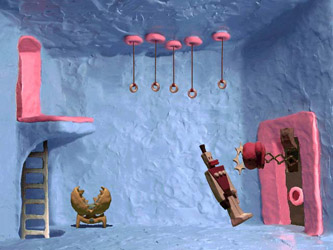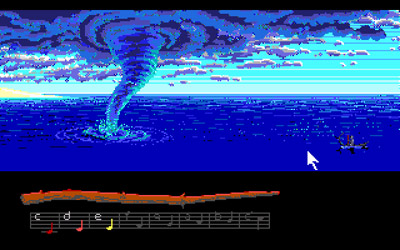Reliable sources have called this “the most incredible season of electronic entertainment on record.” Post-apocalyptic, zombie-bashing, god-playing amusement abounds. But new games take new tech, and those of us without the requisite gear are left out in the cold. Fortunately, like Superman withdrawing to the Fortress of Solitude, I can retreat into the blessed warmth of memory, and relive my top five favorite SF gaming moments. Some social, some solitary, some tragic, some thrilling, these are the sorts of experiences that should keep people gaming for the next 20 years.
5. Conquering the worlds with champion adamantium slingers
Master of Magic, a hybridization of Magic: The Gathering and Sid Meier’s Civilization, is the game I have played, discontinuously, over the longest period of time. I bought it at release (1993), and reinstall every few years. It had massive numbers of spells, races, units, and artifacts, which could be combined in infinite permutations to achieve the perfect strategy for domination of two planes. Everyone had their favorites (Flying invisible warships! Runemaster artificer wizards!), and these were mine. Halflings were the smallest and friendliest of the races, and their best unit was the humble slinger—little rock-tossing hobbity guys. But build them in a city with the right resources, cast the right spells, have the right abilities, and level those suckers up, and suddenly your little rock-tossing guys are pulling down Sky Drakes and Demon Lords like it ain’t no thing at all. Deeply satisfying. Added nostalgia bonus from playing the game with a friend 2-3 days a week after camp for an entire summer.
4. Getting punched in the face by a boxing glove for no reason in the
Neverhood

The Neverhood was a claymation adventure game filled with absurd humor, wonderful music, stunning design, and a fantastically epic proto-steampunk (claypunk?) backstory of robots, god-kings, and literal world-building. I had very little idea what to expect from it when I first started playing. This moment, from the second room in the game, gave the first hint of the weirdness that awaited.
3. The very beginning of Doom
Think back. There was a time when the first person shooter—not the latest iteration, the concept itself —was new and exciting. Upon Doom‘s release, I remember a lot of hype, but not much definite info. But once you hit “play,” you began an entirely unprecedented experience. With the terrifying sounds of heavy breathing, screams, and unidentifiable moans—it’s a portal to hell they opened here, remember—ringing in your ears, you are stranded alone with nothing but a pistol, preparing to take on hell’s legions without number. You got more powerful, with much bigger weapons, and that had its fun parts, but nothing else really compared for generating that first thrill of excitement and fear as being a lone space marine abandoned to his fate with only the pistol to shoot his way out.
Incidentally, I did like the rest of the game, too—until some jerk shouted the codes for infinite weapons and God Mode across the aisles of my local CompUsa (R.I.P.) I did not have the willpower then to resist using them at the hard parts, and that takes all the fun out.
2. Morte’s Revelations
Planescape: Torment is one of my favorite games ever. Set in D&D’s Planescape setting, where bizarre locales (a pregnant alleyway), characters (a reformed succubus), and events (negotiating with the emergent intelligence of a nest of cranium rats) are common, it is an absolute delight, spending as much time on (well-done!) philosophical debate as on combat and questing. It’s a must-play for anyone who wants to experience an interactive fictional world as original and inventive as something like China Mieville’s Bas-Lag. Your character is known as The Nameless One, and you cannot die: you wake up one morning in the mortuary, with no memory of who you are or what you should do. Fortunately, next to you is a floating, talking skull who identifies himself as Morte, and he reads you the tattoo on your back in which you explain to yourself a little bit of what should be going on. From that point on, this chatty, lively character is your loyal companion through more madness and mayhem than I have seen in any other computer RPG. And then, near the end of the game, someone reads to you the part of the tattoo that Morte left off: “Don’t trust the skull.” I remember the wave of confusion, shock, and indignation that swept over me at that moment, and it’s a testament to how engaging the game made its story and characters—my exhibit A evidence for video games as literature.
1. Untwisting the waterspout in Loom
In Loom, probably the most beautiful of the early LucasArts adventure games, you played Bobbin Threadbare, a novice Weaver (of the guild that can Weave reality itself) on a quest to well, save the world, to make a long and complex story short (I’d forgotten this, but apparently the game shipped with a 30 minute introductory audio drama). The magic system was based on short musical tunes, or “drafts,” played on your “distaff”—the manual supplied a few, but most you had to discover. At one point, you are in a boat with a waterspout blocking your path. You search your spells, but nothing fits. You have a “Twisting” draft—what good is that, though? I was stuck—went back to previous screens, looked to see if there was an item I missed, and so on. But nothing.

I played this game with my dad, when I was about 7 years old, and I know that connection is a big part of what made it special. I wasn’t the one who finally got the idea to play the “twist” tune backwards. But I quite well remember the excitement of trying something that seemed totally new and uncertain, and the joy at seeing the waterspout untwist and fall into the water—being rewarded for the leap of logic with pure and total success, and my dad cheering right along with me.
Dishonorable mention: Constantly being killed by my college roommates in Halo. I never quite figured that game out.
So what are some of yours?










